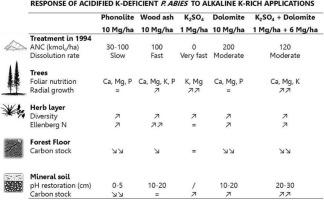对酸化、缺钾的挪威云杉(云杉)林分施用碱性富钾反应的30年监测表明,森林恢复取决于处理类型:岩尘、木灰、白云石和/或硫酸钾
IF 6.6
1区 农林科学
Q1 SOIL SCIENCE
引用次数: 0
摘要
木灰和岩石粉尘被认为是恢复酸化和营养枯竭森林的合适土壤改良剂,但通常缺乏长期数据来证明这种说法。在德国Ochsenhausen的酸化壤土(表层土壤pH-CaCl2 = 3.2)上,监测了缺乏钾的云杉(Picea abies L.)林分施用28年后对这些改良的生物地球化学响应。这5次修正包括木灰(10 Mg/ha)和岩灰phonolite (10 Mg/ha),它们都是指白云岩(10 Mg/ha)、K2SO4 (1 Mg/ha)或两者的组合(1 Mg K2SO4/ha + 6 Mg白云岩/ha)。放射状树的生长对白云石和岩粉没有反应,但对木灰有反应,并且对所有矿物钾处理的反应最强烈,即生长(R2 = 0.83)和叶面钾浓度可以通过处理中施用的有效钾来预测。在木灰处理中,80 cm深度的钙损失最大,主要伴有硝酸盐淋滤(高达35 kg N/ha/yr),但在K2SO4 +白云石混合物(腐殖质溶液pH为5)中,钙损失较为温和。K2SO4处理增加了生态系统碳(C)固存(包括树木生物量和0-40 cm矿质土),比未处理的对照增加1.3 Mg C/ha/年。碱改样地草本层肥力(N)群落加权平均生态指标值(EIVE)略有升高。改良还增加了草本层的多样性指数,但没有造成钙质物种的损失。综上所述,空云石粉尘对恢复森林活力没有作用,钾肥对恢复森林活力的作用最大。K2SO4 +白云石的组合也促进了有机土壤中树木的生长和碳储量,但石灰化效应也降低了森林地表碳储量,导致碳平衡出现抵消效应。本文章由计算机程序翻译,如有差异,请以英文原文为准。

Three decades of monitoring the responses to alkaline K-rich applications in an acidified, K-deficient Norway spruce (Picea abies) stand reveals that forest restoration depends on treatment type: Rock dust, wood ash, dolomite and/or potassium sulphate
Wood ash and rock dust have been suggested as suitable soil amendments to restore acidified and nutrient-depleted forests, but long-term data are generally lacking to justify the claims. The biogeochemical responses to such amendments were monitored during 28 years post applications in a potassium (K)-deficient Picea abies L. stand on acidified loam (topsoil pH-CaCl2 = 3.2) in Ochsenhausen (Germany). The five amendments included wood ash (10 Mg/ha) and the rock dust phonolite (10 Mg/ha), both referenced to dolomite (10 Mg/ha), K2SO4 (1 Mg/ha), or the combination of both (1 Mg K2SO4/ha + 6 Mg dolomite/ha). Radial tree growth did not respond to dolomite or rock dust but responded to wood ash and responded most strongly to all mineral K treatments, i.e., growth (R2 = 0.83) and foliar K concentrations could be predicted by the applied available K in the treatment. The K-feldspar in the rock dust dissolved too slowly to supply sufficient K. Calcium loss from 80 cm depth was highest in the wood ash treatment and was mainly accompanied by nitrate leaching (up to 35 kg N/ha/yr), but it was more moderate with the K2SO4 + dolomite mixture (humus solution pH 5). The K2SO4 treatment increased ecosystem carbon (C) sequestration (including tree biomass and 0–40 cm mineral soil) with 1.3 Mg C/ha/year above the unamended control. The community weighted mean Ecological Indicator Values (EIVE) for fertility (N) slightly increased in the herb layer for the plots that received alkaline amendments. The amendments also increased the diversity indices of the herb layer without the loss of calcifuge species. It is concluded that the phonolite rock dust did not restore forest vitality and that most positive effects are obtained with K fertilisation. The combination of K2SO4 + dolomite also stimulated tree growth and carbon stocks in the organomineral soil, but the liming effect also decreased the forest floor C-stock, leading to counteracting effects on the C-balance.
求助全文
通过发布文献求助,成功后即可免费获取论文全文。
去求助
来源期刊

Geoderma
农林科学-土壤科学
CiteScore
11.80
自引率
6.60%
发文量
597
审稿时长
58 days
期刊介绍:
Geoderma - the global journal of soil science - welcomes authors, readers and soil research from all parts of the world, encourages worldwide soil studies, and embraces all aspects of soil science and its associated pedagogy. The journal particularly welcomes interdisciplinary work focusing on dynamic soil processes and functions across space and time.
 求助内容:
求助内容: 应助结果提醒方式:
应助结果提醒方式:


